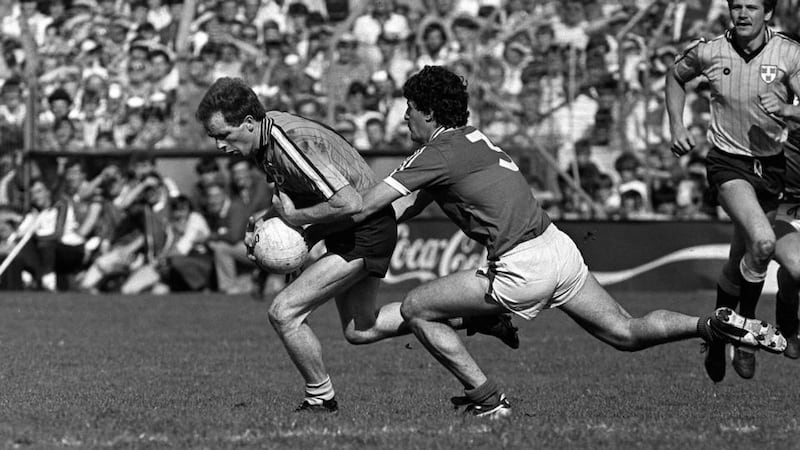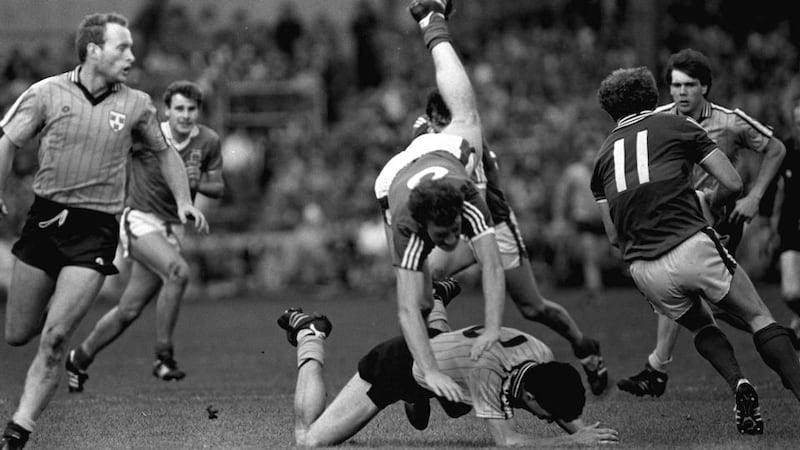He walked away without a backwards glance and his name will not feature much in the deluge of radio conversations and television chats about Mayo football this weekend. But in the heart of the heart of the country, they all know that Liam O’Neill lit the match.
1985: summon it. It was the year of Bob Geldof’s outrage; when the statues moved in Ballinspittle; when they built an airport on the plains outside Knock as if to will the thousands of emigrants home. And it was the year when Mayo football remembered what it was all about. They were 8/1 outsiders to beat Roscommon in that year’s Connacht final but did it anyway and it was serendipity that they went on to meet Dublin in the All-Ireland semi-final.
Playing Kevin Heffernan’s team fired something within the county. Mayo didn’t win but they didn’t quite lose either, stunning the city team and the country in general with a rousing performance which finished in a draw. It turned out that John Finn had his jaw broken in the drawn match and in the long three weeks between the replay, pub and newspaper conspiracies deepened. Mayo were beaten in a replay remembered for Padraic Brogan’s signature goal – a phosphorescent comet through the general blur of the age – and that was that. But in those few weeks, something changed.
“It was tremendous,” smiles O’Neill on an afternoon in Salthill which moves between bursts of sunshine and showers. He is back in his native Galway after years spent sequestered in Mayo and then almost two decades in San Diego. The West hasn’t quite erased the Californian glow and O’Neill looks almost as trim as he did when he rejuvenated Mayo’s belief and ambition.

“We might have caught them on the hop the first day. The disappointing aspect of it was that after the guys seen the reaction. They went to London after that and got a great reception there. There were sponsors looking to come in and there was momentum and it was disappointing that we didn’t push on. We saw what the success had brought to the people of Mayo and to the guys and the potential was there to push it on to the next stage. That would have been very important.”
It is almost impossible now to imagine just how bereft the Mayo game was when he took over the senior team in 1983 as a coaching enthusiast from across the border who was brimming with ideas. But Mayo had lost its way in the national picture. After winning the national league in 1970, they failed to win a Connacht title for the remainder of the decade. When they eventually got out of Connacht in 1981 (beating Sligo 0-12 to 0-4), they ran into Mick O’Dwyer’s threshing machine and were beaten by 2-19 to 1-06.
The idea of winning an All-Ireland would have seemed ludicrous when O’Neill took over the senior post. He had already had a previous existence as a player on the luckless Galway team that immediately followed the three-in-a-row side by losing three All-Ireland finals. It was, he can acknowledge now, a lasting disappointment.
“The psychological point is that you say ‘I’ lost three All-Irelands. But it is ‘we’. It took me a long time to cop that on. I was talking to the other guys and they were using the ‘I’ as well. It is a huge thing to be able to accept. It was disappointing. And for Mayo, no more than Joe Canning with Galway hurling, it was my wish that these boys would get there.”
In 1983, O’Neill had established a reputation as an astute and broad-minded coach with Knockmore: Brogan was one of the players he coached on the way up. Famously, Kevin McStay was handed a championship debut that season without ever training with the county and after they were beaten by three points against Galway on a broiling afternoon, O’Neill decided to start from scratch with their conditioning.
“I brought the guys down to see Dr Tony Watson in Limerick. I recall him saying: ‘Some of these guys should have done this years ago’. I was looked at like I had 10 heads for doing this stuff. And I went to Dr Bob Shepherd at Brigham Young [University]. I knew they were ahead of the curve there for strength and fitness. So I got in touch and he was delighted to help me out. Bought the tapes and had them sent over and got them copied and sent them around. It was an improvement – for the limitations of that time.”

He may have been fortunate to take over at a time when there other chinks of light. John Prenty was an up and coming county board member and O’Neill remembers him as “new school”, ready to help however he could to advance the seniors. The under-21 team had won the 1983 All-Ireland and into the senior fold came Noel Durkin, Peter Ford, Finn, Gabriel Irwin and McStay. Seán Lowry, the two-time All-Ireland winner with Offaly, was living in the county and hesitantly agreed to a request to join the senior panel.
Leaders “He brought a huge amount. But we had some big leaders in that team. A lot of them were realising there mightn’t be a many years left. I always remember we had a very open discussion one weekend above in Brian McEniff’s hotel. In Bundoran. That cleared the air. Lots of things were thrown down from players and management. I felt the issues were the inconsistency of selection. We were trying a lot of players but we needed to tie down players to certain positions. That’s one of the great things about this team.
“Then, it was a matter of trying to get the guys to believe that they could win an All-Ireland. Of putting a bit of steel into their play. Mayo people . . . you couldn’t meet nicer. But there is nothing stopping you having a ruthless streak on the football field within the rules. And some of those guys brought that. Then you have to have the confidence to say we will push on.”
That Finn played through that drawn game with such a serious injury was a reflection of the collective resolve. The injury left him out of the game for eight months. Forty-four thousand attended the drawn game: 63,000 showed up for the replay.
When Dublin and Mayo met in a league game in the spring of 1986, O’Neill was incensed by an off-the-ball incident during the match. “It was ignored by the referee and I challenged him afterwards. After what happened with John Finn, I felt I had to. So I was brought before the [disciplinary] committee – I was given three months. But what I didn’t like was that the Mayo county board decided to put in one of their own guys to mind me. That was completely against my principles.
“And I felt the knives were out then. I felt I should have gotten the backing of the Mayo county board more powerfully. When I went in for the hearing, the chairman was a Galway man and I felt that maybe it would be okay. But there was a certain gentleman at the back and I just got the sense: I’m done here. So I got suspended and not alone that but to be banned from training the team for three months . . . I knew the writing was on the wall. The county board was getting itchy. That was it. That was the run.”
Roscommon edged Galway in the Connacht final of ’86 and O’Neill’s term was over. But something had changed. Within three years, they had taken another step, returning to an All-Ireland final under John O’Mahony in 1989. O’Neill’s son Kevin won an All Star with the county as a teenager in 1993 and had a second coming for his county when Mayo featured in the All-Ireland final of 2006.
Quality coaching
Liam O’Neill was working in America by then as a coaching co-ordinator for the GAA. He stayed in close touch with Mayo and travelled home for the games and soaked up all the knowledge and theory he could from the American sports tradition, meeting with collegiate luminaries like Rick Pitino and Lou Holtz and devouring everything he could read and watch about UCLA’s John Wooden. When he returned to Galway a few years ago, he was more convinced than ever that Fr Quinn had tapped into the future direction for the GAA in all counties. He isn’t convinced that Gaelic games can ever truly go mainstream in America but is more concerned about the care of the game at home.
“Gaelic football has the potential to gain a foothold in America. But the idea of it spreading is far-fetched, in my estimation. And I think we need to take a look at what is happening here first. We are going to have problems with the way the game is going. I think the way forward is all based on getting quality coaches; on tracking people, giving players a pathway so that it all funnels to the senior team. We have good people there. But there is a five-year plan needed. Sell the concept of Gaelic games to young players. You won’t get a big contract but you will get personal satisfaction and it opens up roads and doors and contacts in the business world, whatever. We understate that. People are walking away from games.”
Galway city is crawling with Mayo-ites and, of course, when they see him they are mad to chat about the high innocence of ’85 and of ground reclaimed. Sometimes, too, they will bemoan the aching September feats that would mark the 90s, the noughties and this decade.
O’Neill waves the laments away. He tells them that 30 other counties have envied Mayo in all those years. He reminds them that they keep coming back and keep getting better. He has his reservations about the stultifying caution at the heart of the modern game; the reliance on heavily defensive thinking, the reluctance to kick, the fear of entertaining.
But still, he talks with much more animation about tomorrow’s Mayo team than with the gang he brought out of the twilight 30 years back. It should be no surprise: it’s his nature to push ahead, to look for the next thing. He’ll be there in the crowd tomorrow and laughs at the idea that it will, as it must, be a day of high anxiety for all of Mayo.
“There is always anxiety. Every good performance is based on anxiety so long as it doesn’t overcrowd your thinking. I do think this team have gone through that. It is pay-off time now. I think there comes a time when you have to get the pay-off. I feel they are all on the same wavelength in terms of their positive answer to that question. You have to visualise and see yourself as a champion. They are so fit now and so athletic that I would just say to them: get involved. Don’t wait for Dublin. Bring the game to them.”




















